Redback Spider Australia’s Second Most Venomous Arachnid

Contents
What is a Redback Spider?
The redback spider (Latrodectus hasselti), is the second deadliest spider in the world! It has a black pea-shaped body with a prominent red stripe on its back. A bite from a female redback spider can kill a human, while the male is tiny and harmless.
Redback spiders live throughout Australia. They are not aggressive and avoid humans. Most redback spider bites occur when humans invade the spider's space.
The redback spider is closely related to the Black Widow Spider of the United States. The only differences are that the female redback has a red strip on its back and is the second most dangerous spider in the world, while the black widow is the fifth most dangerous spider.
What Do Redback Spiders Look Like?
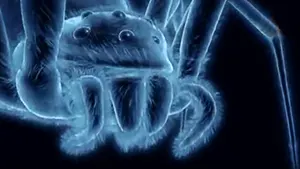
Photo: Redback Spider has 8 eyes
Female Redback Spider
The female redback spider has a body length of about 10mm and a distinct red or orange markings on top of her body. She also has an hourglass-shaped marking on the underside of her body.
Male Redback Spider
The male redback spider is tiny in size compared to the female and harmless. It has a long, light brown body with similar but much paler markings, and at 4 mm in length, it is about 60% smaller than the female and may weigh as little as 1% of a female. The male redback spider is not venomous to humans and is rarely seen except during mating season.
Juvenile Redback Spider
Juvenile female redback spiders have several camouflage-like white markings on their abdomen.
Redback Spider Bite
Yes, a bite from a female redback spider can kill a human! Its bite isn't immediately obvious. Pain sets in about 5–60 minutes after the bite. Within an hour, the entire limb will be painful, and sweating will commence. Abdominal or chest pain may develop, and other parts of the body may also become painful.
Given the slow-acting nature of the redback spider’s venom, you have plenty of time to seek medical treatment. Do not apply a constrictive bandage; the pressure will merely increase the pain. The only recommended action is to administer ice packs to the bite site to help reduce the pain and seek medical help as soon as possible.
Remember, a redback spider is not going to jump out and bite you. Most bites occur due to humans intentionally or unintentionally invading the space of the spider. It is the spider's natural defence is to bite. Most bites occur between December and April, in the afternoon or evening.
Thick clothing, gloves and not poking your hands into places without first checking are some of the simplest precautions against spider bites.
How Redback Spider Venom Affects the Body
The venom of a redback spider is a complex cocktail of toxins and enzymes. These include neurotics which affects the nervous system, myotoxins which affect muscles, haemorrhaging damage the blood vessels and cause bleeding, haemotoxins: destroys the blood, nephrotoxins lead to kidneys failure, cardiotoxins effects the heart and necrotoxins which kills body cells and causes necrosis (dead body tissue). The most potent of these is the neurotoxin called alpha-latrotoxin, which affect vertebrates including humans, causing the overstimulation of neural pathways of the body with a wide range of effects. These include a stinging sensation when first bitten which can become excruciatingly painful, draining of the lymph nodes in the groin, pain throughout the abdomen, chest, neck and head, profuse sweating, mild to severe hypertension and nausea.
The venom produced by the redback spider is more potent than that produced by a king cobra. It would take 136mg of cobra venom to kill an adult male weighing 78kgs. It would take just 46mg of redback spider venom to do the same job. That is roughly 1/3 less.
Only the female redback spider produces venom that is noticeably dangerous to humans. Venom is produced in two glands located in its cephalothorax and expelled through a pair of ducts through its pincers (chelicerae) and finally through its piercing hollow fangs. Redback spiders fangs, at just 0.7mm, are very short, typically if bitten through clothing its will not reach the skin.
Venom vs Poison: What’s the Difference?
Wondered why we keep using the term 'venomous' rather than 'poisonous'? Here is the reason. A venomous animal injects or otherwise delivers its toxin into another animal. While a poisonous animal's entire body or body parts may contain a toxic substance that is harmful if touched or eaten. Because the spider injects its toxins, it is venomous.
Redback Spider Bites Statistics
At least 2,000 redback spider bites are recorded in Australia each year (Note: Some estimates are as high as 10,000). Of these, about 250 people have required antivenom treatment. In most instances, insufficient venom was injected into the victim to be fatal. There has been only one death, in 1979, since an antivenom was first introduced in 1956. Before the introduction of antivenom, 14 deaths had been recorded. In 2016 a Sydney man died in a car accident, after previously being bitten by a redback spider. (That is to say, there isn't clear proof if he died as a result of the bite or from the subsequent accident).
Habitat: Where Do Redback Spiders Live?

Photo: Redback Spider Distribution Map
Redback spiders live throughout Australia. They are found where the climate is warm enough for breeding, and there is adequate food and shelter. Redback spiders are sedentary and remain in the same location their entire lives.
Being peridomestic, the redback spider prefers living in areas occupied by humans (see map) and are most frequently found in urban areas. The reason may be in the increased concentration of insects and other prey in human environments. Redback spiders are be found, in gardens, verandas, in woodpiles, outdoor furniture or inside buildings. A standing Australian joke is being bitten by a redback while seated on the toilet. And, believe it or not, such instances have actually happened.
The Redback Spider Web: Nature’s Deadly Trap
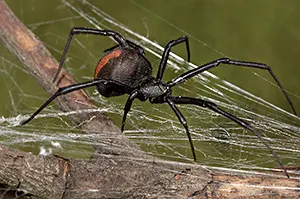
Photo: Redback Spider spinning its web
Only the female redback spins webs. She builds its web in dry, dark, protected areas with sufficient structures to hang its web, such as crevices, shrubs, logs, and tree hollows close to ground level. Male spiders do not build nests but are free-roaming.
The spider’s web is a messy, unstructured tangle of randomly placed threads affixed to supporting surroundings. Although haphazard in appearance, these silk threads with globules of sticky glue are deliberately positioned to trap prey. The web consists of numerous sticky catching threads that trap any creature that comes in contact with them and act as tripwires to alert the spider of activity on its web. As its prey tries to free itself from the web, it is more and more entangled by the strands of silk and held captive for the deadly bite of death, to be inflected by the spider.
The web narrows at the back into a denser funnel-like area where the spider rests and stores its egg sacs. Being mainly nocturnal, the female coming out at night to spin and repair her web.
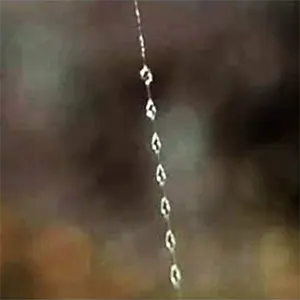
Photo: Stick globules on web
Having built and maintained its web, the redback spider waits patiently, sometimes for months, for prey to run into its trap. In the case of smaller prey, like an ant, the thread to which the ant has got stuck will snap when it struggles and flip the tiny insect further up into the web, truly trapping it. In the case of larger prey, the more it struggles the more it will get trapped by the many strands of the spider's sticky web. Shockwaves will immediately reverberate across the web, altering the spider to some promising activity on its web. It knows to ignore inconsequential incidents such as the wind, a leaf hitting its web, etc. It is well attuned to animate vibrations when they occur.
What Do Redback Spiders Eat?
Redback spiders diet consists of insects, lizards and other animals that get trapped in their webs. They are not intimidated by the size of their prey. There is even a video of a redback spider attacking a venomous red-bellied black snake entangled in its web.
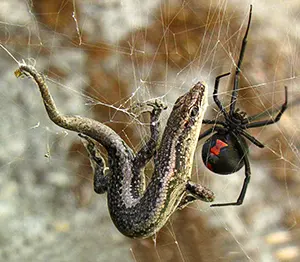
Photo: Redback Spider captures a lizard
Alerted by shockwaves from a struggling victim on its web, the redback spider will approach cautiously to investigate. First, it reaches out and gently touches and smells its prey with the tips of its feet to determine if it is edible or not. If edible, the spider wraps its victim in more of its strong silk threads until the prey is held firmly and cannot retaliate. Then, it will administer the fatal blow—the coup de grace—by repeatedly biting with its pincers and injecting neurotoxic venom into its victim, paralysing and killing it. Once its victim is dead, the redback spider will haul it, if necessary, higher into its web to a suitable feeding station.
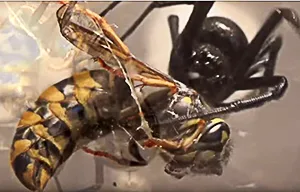
Photo: Redback Spider feeding on a wasp
The redback spider, like all arachnids, has no mouth parts for chewing its meals. It can only suck its meal in liquid form. So it injects very potent digestive enzymes into its prey. These enzymes break down and dissolve the victim's tissue which the spider then sucks up with its straw-like mouth.
Female redbacks also steal food packets stored away by other spiders. It can survive for as long as 3 months without a meal.
Redback Spider: Reproduction
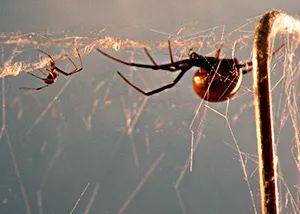
Photo: Male Redback Spider approaches female
A female redback spider secretes sex pheromones onto her web, advertising that she is available to mate. A male will approach her and signal from a safe distance to her to determine if she is receptive to his advances. Any false move on his part could result in her mistaking him for a snack. If she responses non-aggressively, he will approach her.
The male redback spider does not have a penis or other structure to directly transfer sperm from his gonads and deposit it in the female spider's sexual organs. So he has devised an ingenious solution. The male spider collects his sperm from his gonads and enclosed it in a special sac he constructs with silk he releases from his pedipalps (the pair of arm-like appendages on its cephalothorax) and affixes these sperm sacs to each of his pedipalps.
During mating, the male redback spider attempts to deposit his sperm sacs inside the female’s sperm receptacles (spermathecae), located on the underside of her body at the front of her abdomen. The only way he can do this is to stand on his head and try to reach under her with his pedipalps. Unfortunately for him, while he is attempting to deposit his sperm, she squirts her powerful digestive enzymes onto his exposed underbelly dissolving him alive. If he is lucky, he may deposit one or both his sperm sacs inside her before he dies due to his dissolving body. The female will then feed on the male.
Once the female has mated, she can hold the male's sperm in reserve and use it over a period of up to two years, using it to fertilise several batches of eggs. Given this characteristic, she may mate only once in her lifetime.
The female redback then constructs 2–10 silken egg sacs, usually about 1cm in diameter and white in colour, and deposits up to 250 eggs into each. These egg sacs are firmly affixed to the back of her web. Depending on the weather, young spiderlings hatch in two to four weeks.
Redback Spider: Life-Cycle & Dispersal
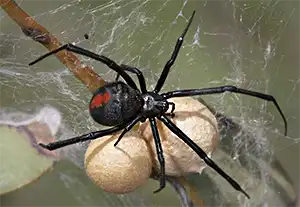
Photo: Redback Spider Guarding its Eggs
Young spiderlings have an interesting way of leaving home. When it is time to leave, they stick their abdomens high in the air to catch the wind and release a droplet of liquid silk, which gets drawn out by the wind and until it forms a long gossamer thread that acts like a paraglider and lifts the little spider and carries it with the air currents on a perilous journey to a new location. Eventually, the thread will entangle or adhere to an object and the young spider will attempt to establish a web of its own there.
Male redback spiders live for 6–7 months, and the females may live for as long as 2–3 years. Redback spider males reach maturity in about 3 months and females in about 4 months. However, very few redback spiderlings survive to reach adulthood as they may be eaten by their siblings, fall prey to predators or become the host to wasp parasites that feed on them.
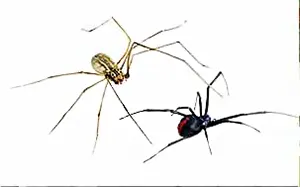
Photo: Daddy Long-legs attacking a Redback Spider
Redback Spider: Predators & Threats
Daddy-long-legs Spiders and white-tailed spiders prey on redback spiders. Ichneumonid wasps sometimes puncture a small hole in a redback spider’s egg sac and deposit its eggs there. The young wasp larvae then feed on the little redback spiderlings. Redback spiders are not endangered.
25 Redback Spider Facts
- The redback spider is the world's second deadliest spider.
- Only the female is highly venomous and has a red stripe on top of her body.
- The male is inconspicuous and is 60% smaller in size compared to the female.
- The male is also not venomous.
- Redback spiders are not aggressive and will keep away from humans.
- Bites occur when humans invade the spider's "space".
- Redback spiders live throughout Australia.
- They seem to like living close to humans.
- This is because of an increase in insects and other prey in human environments.
- The redback spider’s web is a rather messy, unstructured tangle of threads.
- The female comes out at night to spin and repair her web.
- She can wait patiently for months prey to get entangled in her web.
- Redback spiders eat insects, lizards and other animals that get trapped in their webs.
- They are not intimidated by the size of their prey.
- They kill the entangled prey by biting with their pincers and injecting venom into the victim.
- The redback spider has no mouth-parts for chewing its meals.
- So it injects very powerful digestive enzymes into its prey which dissolves the victim's tissue.
- The spider then sucks up the dissolved tissue with its straw-like mouth.
- Female redbacks also steal food packets stored away by other spiders.
- A redback can survive for as long as 3 months without a meal.
- The male redback stands on its head to deposit its sperm.
- The female redback, more often than not, will eat the male after sex.
- She can hold the sperm in reserve and use it for up to two years.
- Most redback spider bites occur between December and April.
- Since the invention of antivenom in 1956, there have been no redback bite fatalities.
Explore More Dangerous Australian Creatures
• Learn About the Funnel Web Spider - The Deadliest Spider in the World→
• Here are More Deadly and Dangerous Australian Animals to Discover →
All Rights Reserved. (Last Updated: Jun 08, 2025)